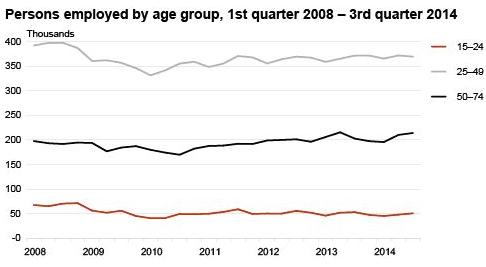Analytics, Employment, Estonia, Labour-market, Markets and Companies
International Internet Magazine. Baltic States news & analytics
Tuesday, 23.04.2024, 18:42
Unemployed persons numbered 51,000 in Estonia in Q3
 Print version
Print version
According to the data of the Labour Force Survey, the estimated number of unemployed persons was 51,000 in the 3rd quarter, which is 4,000 more than in the previous quarter.
The unemployment rate grew by 0.5 percentage points during the same period. Compared to the 3rd quarter of 2013, the number of the unemployed declined slightly (by 2,000; the unemployment rate in the 3rd quarter of 2013 was 7.8%).
Unemployment increased in the 3rd quarter mainly due to the increased number of the short-term unemployed (i.e. people who had been looking for a job for less than a year). They numbered 29,000 in the 3rd quarter (compared to the 2nd quarter, their number was up by 6,000). The number of the long-term unemployed (i.e. people who had been looking for a job for one year or longer) has been stable for the last five quarters and totalled 22,000 in the 3rd quarter. The long-term unemployment rate was 3.3% in the 3rd quarter.
The unemployment rate of persons aged 15–24 was 13.4% in the 3rd quarter, which means that youth unemployment declined compared to both the previous quarter and the 3rd quarter of 2013. The young unemployed numbered 8,000 in total in the 3rd quarter. The unemployment rate of persons aged 15–24 is calculated as a share of only those young people who are economically active (i.e. employed or unemployed), but most members of this age group are still studying. As a result, the share of the unemployed among all young people aged 15–24 was only 5.3% in the 3rd quarter.

The estimated number of employed persons was 634,000 in the 3rd quarter of 2014, which is 4,000 persons more than in the previous quarter and 7,000 persons more than in the 3rd quarter of the previous year. The quarterly increase in employment in the 3rd quarter is fostered by seasonal jobs, for example, in construction. The employment rate of the population aged 15–74 was 63.9% in the 3rd quarter. This is 0.4 percentage points higher than in the 2nd quarter of this year and 1.2 percentage points higher than in the 3rd quarter of 2013 (when the employment rates were 63.5% and 62.7%, respectively).
The employment of the elderly population is growing. In the 3rd quarter, the number of employed persons aged 50–74 increased by 11,000 compared to the same quarter of the previous year. While the employment growth of the elderly population is partly influenced by the gradual rise of the retirement age, the number of young persons in employment is declining due to the entry into the labour market of the small generation born in the 1990s.
Labour force participation is trending upwards – the labour force participation rate, which shows the share of the labour force (total number of the employed and unemployed) in the population aged 15–74, was 69.1% in the 3rd quarter. It was 68% in the same quarter of the previous year. Ten years ago, in 2004, the labour force participation rate was notably lower (63%).
Economically inactive persons (students, retired persons, homemakers, discouraged persons, etc.) made up 31% (306,000 persons) of the population aged 15–74 in the 3rd quarter. Their number decreased by 14,000 compared the same quarter of the previous year. Mainly the number of students and retired persons declined in the working-age population. There was also a decline in the number of discouraged persons (i.e. persons who would like to work but have lost hope to find a job) – they numbered 4,000 in the 3rd quarter.
Unemployment rate is the share of the unemployed in the labour force (the sum of employed and unemployed persons). The long-term unemployment rate is the share of people who have been unemployed for a year or longer among the total labour force. The employment rate is the share of the employed in the working-age population (aged 15–74). The estimates are based on the data of the Labour Force Survey.
Statistics Estonia has been conducting the Labour Force Survey since 1995 and every quarter 5,000 persons participate in the survey. The Labour Force Survey is carried out by statistical organisations in all the European Union Member States on the basis of a harmonised methodology.
Labour Force Survey data for the 2nd quarter of 2014 have been revised; the changes compared to the previously published data are minimal. Starting from the 1st quarter of 2015, Statistics Estonia will not publish the quarterly Labour Force Survey data on economic activities and occupations; the respective data will be published once a year. Statistics Estonia will continue to publish quarterly employment data by economic activity as part of business statistics, national accounts statistics and the statistics on job vacancies and labour turnover.








 «The Baltic Course» Is Sold and Stays in Business!
«The Baltic Course» Is Sold and Stays in Business!

